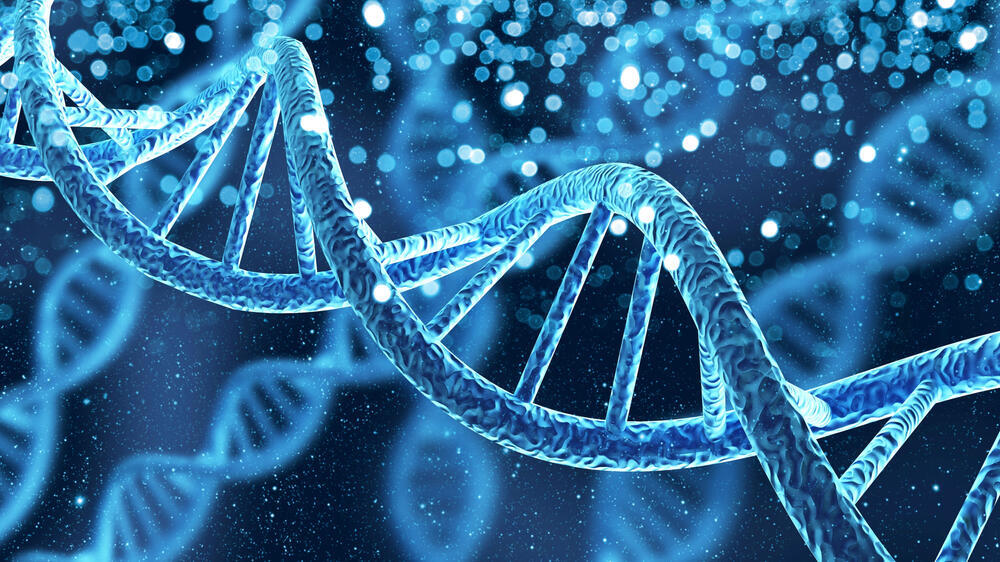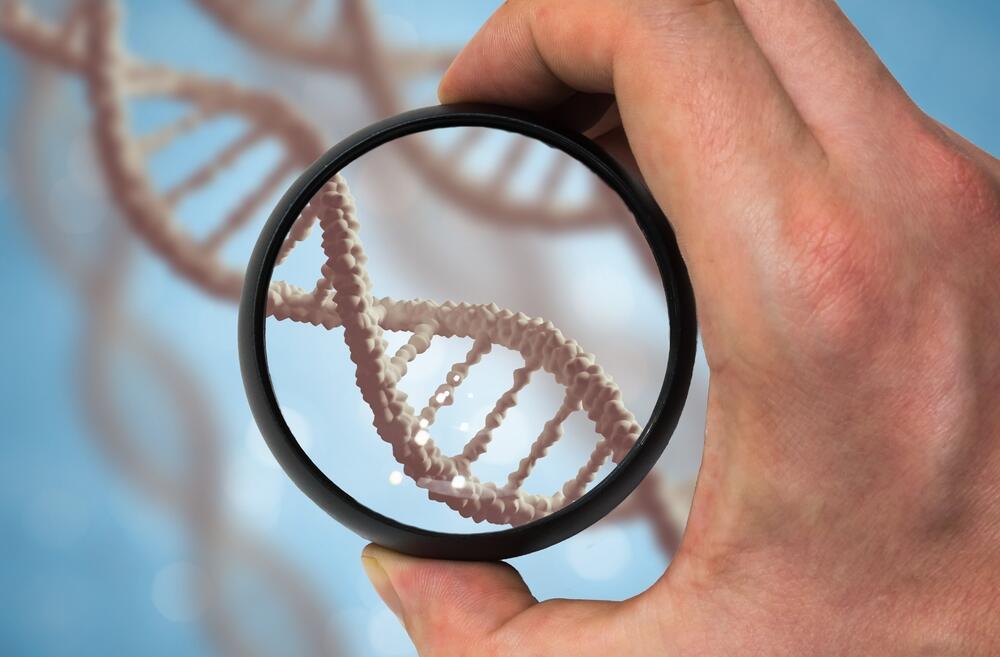Getting your Trinity Audio player ready...
April 25, 1953, was a date of great significance in the history of science. It marked the birth of the field of molecular genetics, which came into being with the publication of a concise research paper by Francis Crick and James Watson in the scientific journal Nature.
More stories:
The article, only one-and-a-half pages in length, presented for the first time the three-dimensional structure of DNA - the molecule that carries the genetic material of most living organisms on our planet, revealing it to be a double helix.
8 View gallery
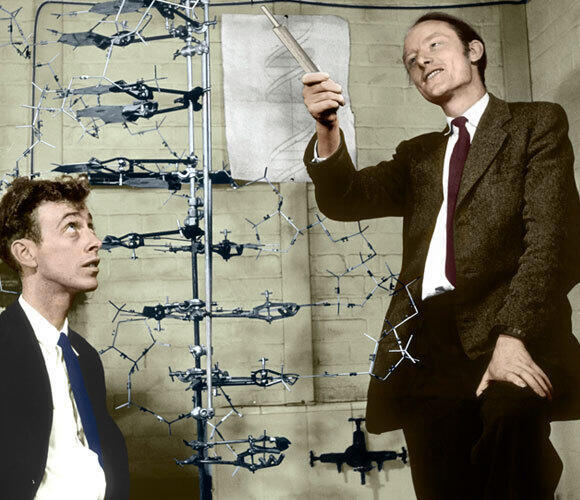

Watson and Crick alongside their DNA model in 1953
(Photo: A. Barrington Brown, © Gonville & Caius College, SPL via Davidson Institute)
This revolutionary discovery constituted one of the most profound breakthroughs of the 20th century, and of science in general, as it revealed the structure of the fundamental molecule that contains the hereditary material of most living organisms in our world.
Three separate paths led to the revolutionary discovery of the double-helical structure of DNA. Two of the paths emerged already in the mid-19th century, while the third came to light at the beginning of the 20th century. It was only a few years prior to the discovery of the double helix that these paths began to converge, ultimately paving the way for the groundbreaking discovery.
On the Shoulders of Giants
The first step in the genetic path took place in the courtyard of the St. Thomas Monastery in the city of Brno in the region of Bohemia, now part of the Czech Republic. There, the monk and biologist Gregor Mendel grew pea plants, created hybrids between several varieties and followed the results for several generations.
In 1865, he published his observations and determined that hereditary traits, such as the color and shape of peas, are passed on in discrete units, such that an offspring shares some traits with the mother and some with the father. This was in contrast to the prevailing concept at the time, which suggested that parental traits intermingle and blend with each other, with the offspring constituting an average of sorts of their parents' traits. The discrete units discovered by Mendel would later be called genes.
The first step in the second path, the chemical one, was taken by the young Swiss doctor Friedrich Miescher in 1868. In search of the secrets of life, he turned his attention to white blood cells.
He isolated cells from pus-soaked bandages provided by a nearby surgical clinic to his laboratory in Tübingen, Germany and attempted to characterize the chemical components of the cell nucleus. In the process, he discovered a substance that was previously unknown, which would later be called DNA.
Wilhelm Röntgen from the University of Würzburg in Germany is responsible for opening the last, physical path. In 1900, while experimenting with vacuum tubes, he noticed strange flickering on a screen that stood far from the tube. Two more weeks of strenuous research convinced him that he had discovered a new type of radiation, which would later be named after him. The discovery earned him the first Nobel Prize in Physics.
Paths Almost Parallel
For two generations, these paths remained separate but continued to progress. The next significant milestone in the scientific journey of genetics was the realization that genes are physically located within the chromosomes – complex structures in the cell nucleus, which in humans consist of 23 pairs. This discovery emerged from a series of studies conducted between 1910 and 1915, and is primarily attributed to the American biologist Thomas Morgan, who also received a Nobel Prize for this achievement.
On the chemical path, Phoebus Levene reached a significant milestone when he deciphered the chemical composition of DNA in 1929. Levene was born in Lithuania and immigrated with his family to the United States after completing his medical studies in St. Petersburg. In his new homeland, he turned to research in biochemistry and discovered that the basic unit of DNA is a nucleotide composed of a nitrogenous base, a sugar and a phosphate group.
However, he was incorrect in determining the structure of the molecule. Nucleotides, or DNA bases, have four different forms, called adenine (A), cytosine (C), thymine (T), and guanine (G), and differ from each other in their nitrogenous bases. Levene believed that the bases were connected to each other in the form of a ring. Such a structure does not allow for the formation of a long chain with a variable sequence of nitrogen bases. This mistake led him, and most of his contemporaries, to reject the possibility that DNA might encode hereditary information.
8 View gallery
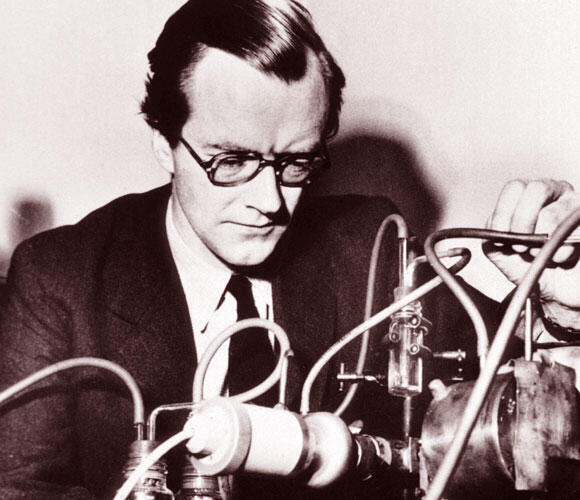

Decoding the structure of the alpha helix, which is found in many proteins. Maurice Wilkins with an X-ray machine in his laboratory
(Photo: National Library of Medicine, SPL via Davidson Institute)
Both of these discoveries were preceded by two other important discoveries in the physical path. First, German physicist Max von Laue discovered in 1912 that crystals could be used to study X-rays, since the distance between atomic layers in crystals corresponded precisely to the wavelengths of X-rays.
A year later, William Henry Bragg and his son William Lawrence Bragg took the opposite approach: while Laue had shown that crystals were useful for the study of X-rays, Bragg Sr. and his son demonstrated that X-rays could be used for studying the chemical structure of crystals.
In doing so, they laid the foundation for the science of crystallography, which enables scientists to decipher the three-dimensional structure of the molecules that make up a crystal by analyzing the diffraction pattern of X-rays, i.e., the scattering pattern of the rays when they hit the crystal. The three of them were awarded Nobel Prizes for these discoveries. To this day, the Bragg father-and-son duo remain the only father-and-son pair to have shared a Nobel Prize in science for joint work.
The race is on
The breakthrough that first hinted at the connection between the three paths was achieved by Oswald Avery from the Rockefeller Institute. In 1944, he proved that genetic information is transmitted by DNA, and not by proteins as previously believed.
Shortly thereafter, Austrian chemist Erwin Chargaff made a significant discovery in the chemical path, when he identified the base pairing rule, which states that DNA consists of pairs of bases, with the number of each one of the bases always being the same: adenine with thymine, and cytosine with guanine. It soon became clear that this was a key principle for understanding the function of DNA and an important clue for deciphering its structure.
The race to understand DNA reached its peak. However, deciphering the structure of a complex molecule required expertise in crystallography, as it could not be achieved using conventional chemical methods.
Three main groups stood at the forefront: Maurice Wilkins' group at King's College in London; Linus Pauling from the United States, who had recently deciphered the structure of the alpha helix, a shape found in many proteins; and two scientists who were not particularly well-known at the time: James Watson, the American, and Francis Crick, the Englishman, who worked in Lawrence Bragg's laboratory in Cambridge, England.
Wilkins' group was significantly strengthened by the addition of the young crystallographer Rosalind Franklin, who managed to produce excellent X-ray diffraction images of DNA.
The progress of the pacifist Pauling was delayed when a US Senate committee, led by Sen. Joe McCarthy, prevented him from attending an important conference in Europe, claiming that he was a communist. Had he been able to participate, he might have been exposed to information that would have advanced his progress in deciphering the structure of DNA.
Double helix on a personal level
The relationship between the two English groups fluctuated between competitive tension and cooperation. In this context, Watson and Crick managed to access Franklin's photos without her knowledge.
While Franklin focused on collecting more crystallographic data, the Cambridge duo deduced that the structure was helical and began constructing a model. To do this, they cut out the shapes of nucleotide molecules from cardboard and tried to arrange them in the form of a helix. Their rivals displayed disdain for this approach, which they did not consider proper science.
8 View gallery
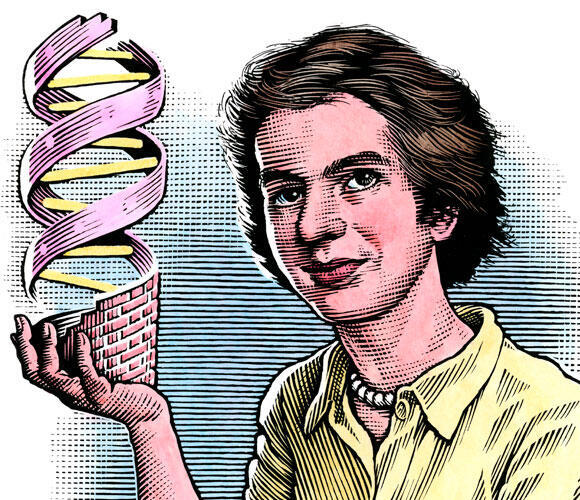

Watson and Crick utilized images obtained by the skilled crystallographer, Rosalind Franklin, to develop their DNA model
(Illustration: Bill Sanderson, SPL via Davidson Institute)
Among the skeptics was Chargaff, who had encountered Watson and Crick a year earlier. Their senior colleague John Kendrew had arranged the meeting, stating, "Chargaff is the man who knows the most about DNA."
The accounts of Chargaff and Watson suggest that the encounter was tense. Chargaff wrote in his memoirs, "So far as I could make out, they wanted, unencumbered by any knowledge of the chemistry involved, to fit DNA into a helix [...] I told them all I knew. If they had heard before about the pairing rules, they concealed it. But as they did not seem to know much about anything, I was not unduly surprised."
In a 2002 newspaper interview, Watson recounted the period when they were working on the model, saying, "Francis came back and asked, 'What about Chargaff’s pairs? Could they connect to each other?' But I couldn't stand Chargaff since we met him a year before. I told myself that I didn't want to use his data in finding the structure. [...] It was really foolish."
It is widely believed that Franklin was the main victim in this story, and there is merit to this perspective. Her paper containing crystallographic data, published in the same issue of the Nature journal following Watson and Crick's paper, received little attention, as did another paper she published a few months later that provided substantial evidence for the double helix structure.
Raymond Gosling, Franklin's student and co-author of both papers, whose contribution to deciphering the structure of DNA has also been largely overlooked, spoke in later days about her reaction. When he asked if she was upset about the recognition she had been denied, she responded: "After all, we all stand on each other's shoulders."
Franklin, who had a strained relationship with Wilkins, the leader of the London group, parted ways with her colleagues shortly after the tumultuous events of spring 1953. Tragically, she succumbed to cancer just a few years later at the young age of 38. Gosling completed his doctorate under Wilkins' supervision but eventually left the field of molecular biology.
Contrary to popular belief, the Nobel Prize Committee did not overlook Franklin when awarding the prize for the discovery of DNA's structure, as she had already died, and Nobel Prizes are not awarded posthumously. The committee acknowledged the London group's contribution by including Wilkins as a co-recipient alongside Watson and Crick. Regrettably, this detail has often been obscured in the annals of history.
Getting to the heart of the problem
Thus ended the scientific and human drama, with history seemingly behaving with ironic mischief by awarding the wreaths of victory to those who were once deemed hopeless amateurs. Nevertheless, the Cambridge group probably deserved more recognition than they received.
More than anything, this story reflects the enduring debate between meticulous science - which adheres to established rules, and daring speculation - which propels science forward by leaps and bounds. Franklin and Gosling's crystallographic images, along with Chargaff’s pairing rules, provided crucial clues to solving the puzzle.
However, it must be acknowledged that Watson and Crick's decision to tackle the heart of the problem without getting bogged down in "trifles" such as collecting crystallographic data and understanding the relevant chemistry, required considerable courage.


